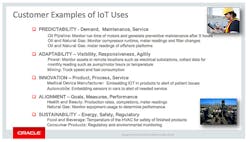The Internet of Things (IoT): Opportunities for Smarter Supply Chains
Supply chains coordinate and balance people, activities and resources to make and move a product to deliver to customers. It involves the coordination and flow of goods, cash and information. Every company tries to balance and optimize their supply chain to improve profitability and better customer service. The Internet of Things (IoT) is enabling more and faster information across the supply chains for better decisions, planning and execution.
New market opportunities are available to companies in almost every industry from the data that IoT delivers. These new opportunities could be as simple as getting information from sensors about what is happening on the manufacturing plant floor causing automatic manufacturing updates, potential adjustment to customer order delivery dates or even a maintenance work request to handle a detected equipment malfunction. All of these opportunities cause changes to be made to the supply chain.
With IoT becoming much more affordable, companies, for example, are embedding IoT sensors in their products that "phone home" with product status. The supply chain must adapt because now a new service is able to be provided for proactive support and this requires people and activities be instituted to provide this support.
Companies that were previously known for the products they sold are now delving into new areas such as customer service management. For example, a company that sold printers now might also sell subscription services to automatically deliver printing supplies based on actual usage of the printer.
New market opportunities are available to companies in almost every industry from the data that IoT delivers.
Companies that were previously known for the products they sold are now delving into new areas such as customer service management. For example, a company that sold printers now might also sell subscription services to automatically deliver printing supplies based on actual usage of the printer. IoT provides the ability to monitor actual customer product usage while the supply chain must adapt to insure that the supplies such as ink are delivered to the customer whereas the previous sales model was to just sell supplies when the customer requested.
The IoT allows organizations to reach outside their own company to build better supply chains. By receiving and sending information to business partners upon sensing a change, companies can adapt and respond more quickly. These benefits have direct impact on top-line revenue and gain unprecedented operational and supply chain efficiencies.
Organizations recognize IoT as a strategic initiative as evidenced by this recent survey conducted by Forrester Consulting on behalf of Zebra Technologies. Key findings include:
- Over 80% of surveyed firms indicate IoT solutions will be the most strategic technology initiative for their organization.
- There is a strong IoT solution deployment momentum with nearly 65% of surveyed firms having deployed, or are implementing, IoT.
- Organizations can achieve a wide range of business benefits from IoT solutions with the leading benefit being improved customer experience.
Opportunities for Smarter Supply Chains
There are several key opportunities that companies can exploit by leveraging IoT technology to gain competitive advantages:
Better Predictability of Demand & Inventory Visibility: IoT can enable companies to achieve better predictability of demand through real-time visibility of demand and service signals. With better predictability, planning & execution tools, companies can adjust pricing and promotions strategies to shape demand, move additional product quickly, drive revenue growth, and further expand margins for a high-demand product with limited market supply.
The output of the planning tools can then enable dynamic shelving in retail and consumer goods industries and can adjust truck destinations, routes and truck types when shipping in response to this more accurate and timely information. For example, if the demand for a product is high, the supply chain needs to adjust to purchase the additional raw materials, plan the capacity to meet this additional demand, and deliver the product to the retailer to take advantage of the new IoT signal.
As production changes to meet shifting product demand, there is now a requirement for more nimble inventory systems. The traditional inventory management systems offer tracking of inventory from the time you receive items from the vendor until the finished goods are shipped to the customer. IoT enhances this traditional system by enabling real time visibility and tracking of inventory, which can result in reduced inventory and spoilage or expiration of products.
IoT can address compliance and regulatory reporting requirements such as traceability, emissions, country of origin and others. In addition, with IoT, organizations are better able to track shipped items for the purpose of returns, warranties and predictive support of failing items.
Better Tracking & Efficiency: IoT can provide more advanced insight into the effectiveness of equipment and other operating assets. It is not enough to know when assets have issues. There is also a need to understand operational “uptime” of machine assets in a plant as well as more sophisticated quality of end product based on efficiency of the output of shop floor assets spread across hundreds of plants across the world.
IoT-enabled sensors on older, non-automated equipment now enable health and production information to be collected from assets that were previously not able to be monitored remotely. Organizations can now see and track their entire production facility virtually. In addition, environmental conditions and equipment operating conditions can be monitored to ensure that the equipment is being operated properly and prevent unforeseen machine failures.
The benefit of IoT is the system can read asset health data to determine which assets are not working efficiently or are in need of preventive maintenance, and automatically create work orders for the problems to be solved. This proactive approach to maintenance reduces costly and potentially time-intensive equipment failure.
Organizations that have assets external to their facility, such as trucks or other moving assets, can easily track the location, status and availability of these remote assets. Since these assets are crucial to deliver products and provide services, the ability to have the visibility facilitates the nimbleness required to re-deploy as needed.
An example would be a refrigerated truck delivering perishable goods. The temperature, humidity and other factors need to be monitored to guarantee product quality, safety and compliance. This ability to monitor the truck locally by the driver and remotely by the organization enables a replacement vehicle or repair when issues are encountered before the product spoils.
Accelerated Innovation & Product Support: IoT embedded in products can send real time customer feedback to manufacturers on the usage, success and failure of a product. This can aid manufacturers in design decisions made in the early cycles of product development to enhance and optimize for supply and manufacturability. In addition, this information can be shared with key suppliers during product innovation and development processes to further improve product capabilities.
An IoT-enabled product that you sell to your customers could communicate back to your maintenance organization the current status, diagnostic information, and available quantity of consumables. This information will allow companies to deliver a better quality of service to customers by capturing potential failures before they have an impact and also increase your revenue through expanded service offerings and replenishment of consumables.
Improved Alignment & Collaboration: S&OP processes provide coordination among sales, manufacturing, and distribution, but there are still disconnects and gaps among sales, marketing, strategy, and operations in many companies. Often this is caused by lag time in demand, supply, inventory and supply chain information.
IoT can enhance the S&OP process by providing real-time visibility to all the key dimensions for success--demand, supply, inventory, product, risk, and performance--across the organization and throughout the extended supply chain. Real-time visibility of performance and collaboration can enable companies to improve alignment across the enterprise to achieve the right balance of supply and demand, aligned with strategic business goals.
Sustainability & Quality: The triple bottom line of people, profit and planet has never been more important than it is today. Studies show that companies striving for social and environmental sustainability achieve major competitive advantages, especially with regard to production efficiency, supplier management skills, and attractiveness to employees.
IoT-enabled sustainable operations can provide real-time visibility to energy and resource consumption and resource or material movement. This can result in the reduction of carbon inefficiencies, minimized energy consumption, less waste with "recycle-reuse-refurbish" materials, and optimized travel and transportation.
Additionally, IoT can provide a controlled approach to quality management, helping you identify defects at the source. By incorporating user-defined checkpoints for key operations, you can verify that items meet standards and design specifications from material receipt to the shipment of the end product. In terms of safety, IoT applications can help companies monitor atmosphere, radioactivity, sound, pressure, temperature, etc. using remote sensors to ensure the safety of your workers.
IoT Strategy and the Right Processes, Practices, and Tools Can Help
The demands on supply chain managers to rapidly respond to change and increase profitability are greater than ever. The good news is that IoT can provide significant opportunities for companies to deliver value and improve performance through better predictability, adaptability, innovation, alignment and sustainability across the value chain. There is a clear call to action for supply chain professionals to explore, understand and exploit IoT for enhanced supply chain performance. To that end, supply chain executives must come up to speed on IoT rapidly, specifically:
- Understand how IoT can benefit your supply chain and enterprise through real time information visibility enabled through integration of Machine to Machine (M2M) and Device to Application (D2A) models
- Analyze your current gaps and identify specific supply chain use cases that will demonstrate quick wins for your enterprise.
- Deploy or pilot specific IoT-enabled solutions to ensure success and realize key benefits.
- Develop an enterprise-wide deployment plan and architecture with use cases to further leverage IoT capabilities across processes and company. This includes data storage and analytic tools to handle the large amounts of sensor data.
- Scale globally with IoT business partners ready to further improve your supply chain processes and transform your supply chain for the 21st century





